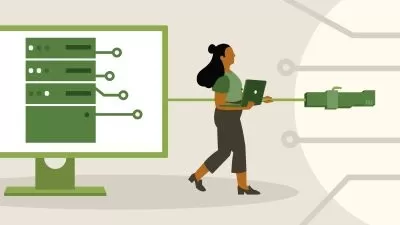UWP Universal Windows Platform Mastery
EDUCBA Bridging the Gap
25:59:13
Description
Unlock the full potential of Windows app development with our comprehensive UWP Universal Windows Platform course
What You'll Learn?
- Introduction to UWP: Students will be introduced to the core concepts of UWP, the advantages of one core operating system, one store, and one developer center
- Design and Development Paradigms: Learners will explore design paradigms, development roadmaps, and best practices for creating intuitive and UWP apps
- XAML and UI Development: Students will dive deep into XAML, the markup language used for designing UWP interfaces.
- Event Handling and Navigation: The course covers how to handle events in UWP apps, navigate between pages, and manage the app’s lifecycle.
- Intermediate and Advanced UWP Features: Learners will study more complex topics such as adaptive UI, typography, hamburger menus, effective pixels, snap points
- Hands-on Projects: The course includes practical projects where students will build multiple UWP apps, applying the concepts learned.
- Data Binding and Management: Students will learn about data binding techniques, managing data templates, and implementing data-driven features
- Final Projects and Submission: By the end of the course, learners will be able to build, package, and submit their UWP applications to the Microsoft Store
Who is this for?
What You Need to Know?
More details
DescriptionIntroduction
Welcome to the UWP Universal Windows Platform course, where you'll embark on a journey to master the development of modern, responsive, and feature-rich applications for the Windows ecosystem. This course is meticulously designed to cater to beginners, intermediate, and advanced developers, ensuring a comprehensive understanding of UWP and its vast capabilities.
Section 1: UWP Universal Windows Platform - Beginners
In the beginner's section, you will be introduced to the fundamentals of the Universal Windows Platform. You will explore the core concepts such as the unified operating system, the single store for app distribution, and the centralized developer center. This section will also cover the essential features of Windows 10 and guide you through setting up your environment to start developing UWP applications. By the end of this section, you will have a solid foundation in UWP and be ready to create your first "Hello World" application.
Section 2: UWP Universal Windows Platform - Intermediate
The intermediate section delves deeper into the development aspects of UWP using XAML (Extensible Application Markup Language). Here, you will learn to create and customize UI components, handle events, and apply themes and styles to your applications. The section emphasizes the importance of design paradigms and navigation models, ensuring that your applications are not only functional but also visually appealing and user-friendly. You will also explore the differences between emulators in various Windows versions, which is crucial for testing and debugging your apps.
Section 3: UWP Universal Windows Platform - Advanced
The advanced section is tailored for developers looking to leverage the full potential of UWP. You will learn about adaptive UI techniques, typography, and effective use of pixels to create responsive applications that work seamlessly across different devices. This section also introduces advanced XAML controls, split view control, and adaptive visual states. By mastering these concepts, you will be able to create sophisticated, high-performance applications with a professional look and feel.
Section 4: Projects on UWP - Building 4 UWP Apps
In the final section, you will apply your knowledge by working on four comprehensive UWP projects. These projects will cover a wide range of functionalities, from simple form applications to complex layout apps. You will gain hands-on experience with various XAML properties, data binding, navigation, and adaptive layouts. This practical approach will solidify your understanding and prepare you to tackle real-world UWP development challenges confidently.
Conclusion
By the end of this course, you will have a thorough understanding of UWP, from the basics to advanced concepts. You will be equipped with the skills to develop, design, and deploy high-quality Windows applications that can run on any device within the Windows ecosystem. This course is your gateway to becoming a proficient UWP developer, ready to innovate and create impactful applications.
Who this course is for:
- Aspiring Developers: Beginners who are new to programming and want to start their journey with a comprehensive introduction to Universal Windows Platform (UWP) development.
- Experienced Developers: Developers who are familiar with other programming languages and platforms and want to expand their skills by learning how to create applications for the Windows 10 ecosystem using UWP.
- Software Engineers: Professionals looking to enhance their knowledge of UWP to build robust and scalable Windows applications.
- Students: Computer science and engineering students who want to learn UWP development as part of their academic curriculum or personal interest.
- Hobbyists and Enthusiasts: Technology enthusiasts and hobbyists who enjoy exploring new platforms and want to create Windows apps for personal projects or as part of a portfolio.
- Freelancers and Independent Developers: Individuals seeking to develop and publish their own applications on the Microsoft Store, leveraging the unique features and capabilities of the UWP platform.
- Project Managers and Technical Leads: Professionals who need to understand UWP development to manage and lead teams working on Windows applications.
Introduction
Welcome to the UWP Universal Windows Platform course, where you'll embark on a journey to master the development of modern, responsive, and feature-rich applications for the Windows ecosystem. This course is meticulously designed to cater to beginners, intermediate, and advanced developers, ensuring a comprehensive understanding of UWP and its vast capabilities.
Section 1: UWP Universal Windows Platform - Beginners
In the beginner's section, you will be introduced to the fundamentals of the Universal Windows Platform. You will explore the core concepts such as the unified operating system, the single store for app distribution, and the centralized developer center. This section will also cover the essential features of Windows 10 and guide you through setting up your environment to start developing UWP applications. By the end of this section, you will have a solid foundation in UWP and be ready to create your first "Hello World" application.
Section 2: UWP Universal Windows Platform - Intermediate
The intermediate section delves deeper into the development aspects of UWP using XAML (Extensible Application Markup Language). Here, you will learn to create and customize UI components, handle events, and apply themes and styles to your applications. The section emphasizes the importance of design paradigms and navigation models, ensuring that your applications are not only functional but also visually appealing and user-friendly. You will also explore the differences between emulators in various Windows versions, which is crucial for testing and debugging your apps.
Section 3: UWP Universal Windows Platform - Advanced
The advanced section is tailored for developers looking to leverage the full potential of UWP. You will learn about adaptive UI techniques, typography, and effective use of pixels to create responsive applications that work seamlessly across different devices. This section also introduces advanced XAML controls, split view control, and adaptive visual states. By mastering these concepts, you will be able to create sophisticated, high-performance applications with a professional look and feel.
Section 4: Projects on UWP - Building 4 UWP Apps
In the final section, you will apply your knowledge by working on four comprehensive UWP projects. These projects will cover a wide range of functionalities, from simple form applications to complex layout apps. You will gain hands-on experience with various XAML properties, data binding, navigation, and adaptive layouts. This practical approach will solidify your understanding and prepare you to tackle real-world UWP development challenges confidently.
Conclusion
By the end of this course, you will have a thorough understanding of UWP, from the basics to advanced concepts. You will be equipped with the skills to develop, design, and deploy high-quality Windows applications that can run on any device within the Windows ecosystem. This course is your gateway to becoming a proficient UWP developer, ready to innovate and create impactful applications.
Who this course is for:
- Aspiring Developers: Beginners who are new to programming and want to start their journey with a comprehensive introduction to Universal Windows Platform (UWP) development.
- Experienced Developers: Developers who are familiar with other programming languages and platforms and want to expand their skills by learning how to create applications for the Windows 10 ecosystem using UWP.
- Software Engineers: Professionals looking to enhance their knowledge of UWP to build robust and scalable Windows applications.
- Students: Computer science and engineering students who want to learn UWP development as part of their academic curriculum or personal interest.
- Hobbyists and Enthusiasts: Technology enthusiasts and hobbyists who enjoy exploring new platforms and want to create Windows apps for personal projects or as part of a portfolio.
- Freelancers and Independent Developers: Individuals seeking to develop and publish their own applications on the Microsoft Store, leveraging the unique features and capabilities of the UWP platform.
- Project Managers and Technical Leads: Professionals who need to understand UWP development to manage and lead teams working on Windows applications.
User Reviews
Rating
EDUCBA Bridging the Gap
Instructor's Courses
Udemy
View courses Udemy- language english
- Training sessions 179
- duration 25:59:13
- Release Date 2024/10/06











